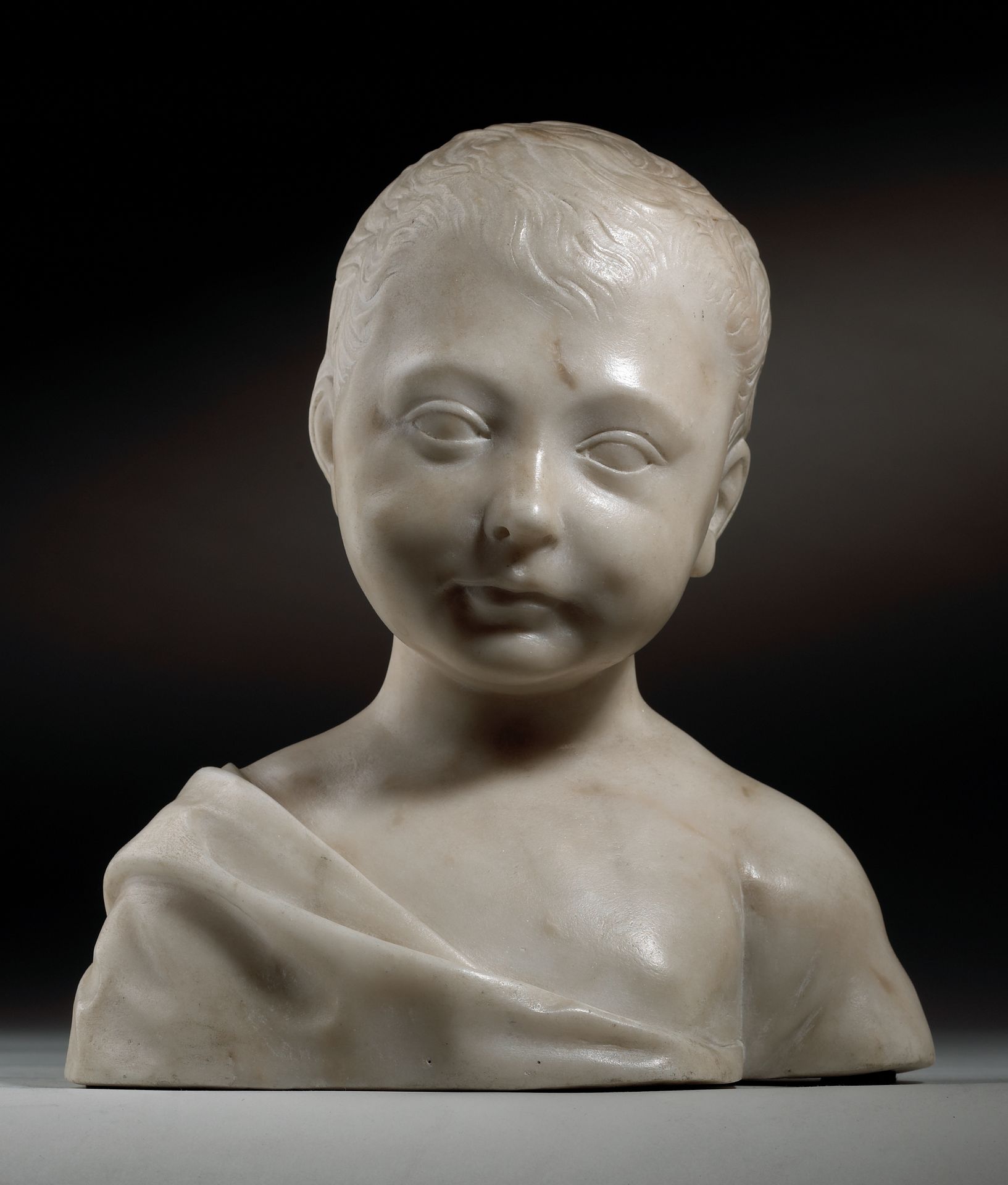Description
DESIDERIO DA SETTIGANO (1428-1464), cercle de BUSTE DU CHRIST ENFANT Italie, Florence, moitié du XVe siècle Marbre 25 x 28 cm Ce buste de jeune enfant renvoie aux représentations d’enfants saints dans les maisons florentines de la Renaissance, afin de fournir aux enfants des modèles de piété à suivre (cf.Paolozzi Strozzi, op.cit., p.119). Présenté de face, la tête légèrement inclinée vers la gauche et vers l’avant. Le visage est caractérisé par un oval arrondi, les joues gonflées, les traits d’une grande finesse. La coiffure très fine elle aussi est transcrite par des sillons creusés en surface mais au rendu très naturel. Le buste a moitié dénudé, l’épaule droite est recouverte par un drapé. Ce buste est étroitement lié à deux bustes en marbre sculptés de Desiderio da Settignano (1430-1464), et conservés à la National Gallery à Washington (fig.1-2) et qui sont parfois considérés comme représentant l’Enfant Christ. D’autres bustes comparables de l’Enfant Jésus et de Saint Jean ont été sculptés par les contemporains de Desiderio, Antonio Rossellino et Mino da Fiesole. CIRCLE OF DESIDERIO DA SETTIGNANO, A MARBLE BUST OF THE CHRIST CHILD, MID 15TH CENTURY, FLORENCE, ITALY Dim. 25 x 28 cm This bust of a young child refers to the representations of holy children in the florentine Renaissance houses, in order to provide to children models of piety to follow (cf. Paolozzi Strozzi, op.cit., p.119). Facing front, the head slightly angled to the left and forward. The face is characterized by a rounded oval, the cheeks swollen, the features of great finesse. The very fine hairstyle is rendered by thin carved locks on the surface of the marble, yet with great realism. The bust is half naked, the right shoulder is covered. This bust is to be related to two sculpted marble busts by Desiderio da Settignano (1430-1464), and kept at the National Gallery in Washington (fig. 1-2) and who are sometimes considered to represent the Christ Child. Other comparable busts of the Christ Child and Saint John were sculpted by the contemporaries of Desiderio, Antonio Rossellino and Mino da Fiesole.
19
DESIDERIO DA SETTIGANO (1428-1464), cercle de BUSTE DU CHRIST ENFANT Italie, Florence, moitié du XVe siècle Marbre 25 x 28 cm Ce buste de jeune enfant renvoie aux représentations d’enfants saints dans les maisons florentines de la Renaissance, afin de fournir aux enfants des modèles de piété à suivre (cf.Paolozzi Strozzi, op.cit., p.119). Présenté de face, la tête légèrement inclinée vers la gauche et vers l’avant. Le visage est caractérisé par un oval arrondi, les joues gonflées, les traits d’une grande finesse. La coiffure très fine elle aussi est transcrite par des sillons creusés en surface mais au rendu très naturel. Le buste a moitié dénudé, l’épaule droite est recouverte par un drapé. Ce buste est étroitement lié à deux bustes en marbre sculptés de Desiderio da Settignano (1430-1464), et conservés à la National Gallery à Washington (fig.1-2) et qui sont parfois considérés comme représentant l’Enfant Christ. D’autres bustes comparables de l’Enfant Jésus et de Saint Jean ont été sculptés par les contemporains de Desiderio, Antonio Rossellino et Mino da Fiesole. CIRCLE OF DESIDERIO DA SETTIGNANO, A MARBLE BUST OF THE CHRIST CHILD, MID 15TH CENTURY, FLORENCE, ITALY Dim. 25 x 28 cm This bust of a young child refers to the representations of holy children in the florentine Renaissance houses, in order to provide to children models of piety to follow (cf. Paolozzi Strozzi, op.cit., p.119). Facing front, the head slightly angled to the left and forward. The face is characterized by a rounded oval, the cheeks swollen, the features of great finesse. The very fine hairstyle is rendered by thin carved locks on the surface of the marble, yet with great realism. The bust is half naked, the right shoulder is covered. This bust is to be related to two sculpted marble busts by Desiderio da Settignano (1430-1464), and kept at the National Gallery in Washington (fig. 1-2) and who are sometimes considered to represent the Christ Child. Other comparable busts of the Christ Child and Saint John were sculpted by the contemporaries of Desiderio, Antonio Rossellino and Mino da Fiesole.
